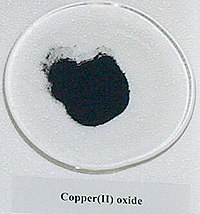
Photo from wikipedia
Copper sulfide (CuS) is an attractive electrode material for batteries, thanks to its intrinsic mixed conductivity, ductility and high theoretical specific capacity of 560 mAh g−1. Here, CuS is studied… Click to show full abstract
Copper sulfide (CuS) is an attractive electrode material for batteries, thanks to its intrinsic mixed conductivity, ductility and high theoretical specific capacity of 560 mAh g−1. Here, CuS is studied as cathode material in lithium solid‐state batteries with an areal loading of 8.9 mg cm−2 that theoretically corresponds to 4.9 mAh cm−2. The configuration of the cell is LiLi3PS4[CuS (70 wt%) + Li3PS4 (30 wt%)]. No conductive additive is used. CuS undergoes a displacement reaction with lithium, leading to macroscopic phase separation between the discharge products Cu and Li2S. In particular, Cu forms a network of micrometer‐sized, well‐crystallized particles that seems to percolate through the electrode. The formed copper is visible to the naked eye. The initial specific discharge capacity at 0.1 C is 498 mAh g(CuS)−1, i.e., 84% of its theoretical value. The initial Coulomb efficiency (ICE) reaches 95%, which is higher compared to standard carbonate‐based liquid electrolytes for the same cell chemistry (≈70%). After 100 cycles, the specific capacity reaches 310 mAh g(CuS)−1. With the current composition, the cell provides 58.2 Wh kg−1 at a power density of 7 W kg−1, which is superior compared to other transition metal sulfide cathodes.
Journal Title: Advanced Energy Materials
Year Published: 2020
Link to full text (if available)
Share on Social Media: Sign Up to like & get
recommendations!